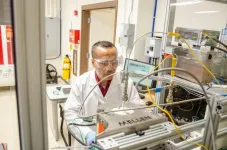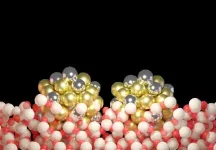(Press-News.org) Self-monitoring of physical activity with an accelerometer and feedback is an effective tool to improve physical activity in elderly people requiring long-term support. The Kobe University study is the first to show that with simple and safe means the physical activity of this demographic can be improved, which is expected to help prevent serious illness and reduce costs for long-term care.
Taking more steps and sitting less is well known as having a significant influence on a wide range of noncommunicable diseases such as heart disease, diabetes, orthopedic diseases and stroke. This is particularly problematic in senior citizens who depend on long-term care such as in day-care centers, as it is known that they take fewer steps and spend more time sitting than healthy people of similar age. The resulting higher risk of falling ill not only decreases health-related quality of life in these people, it also stretches already scarce resources in healthcare systems. And while it is known that self-monitoring can improve the physical activity even among the elderly, the effectiveness of this approach has not been shown for this high-risk demographic.
The Kobe University research team of health scientists IZAWA Kazuhiro and KITAMURA Masahiro filled this gap by conducting a comparative analysis with 52 long-term care patients at a day care center in Japan on the effectiveness of self-monitoring of physical activity. They educated the participants on the importance of increasing physical activity and asked participants to wear accelerometers that record steps, sitting time and activity of various intensity. The 26 participants in the intervention group were additionally asked to record their progress in a calendar daily and received weekly feedback and advice.
The results now published in the journal European Geriatric Medicine show that the intervention group took more steps, spent less time sitting and were more engaged in light physical activity. The authors write, “The results of this intervention promoting physical activity in this target population were novel to this study. Older people with long-term care needs have reduced mobility and activity compared to healthy older people, so increasing physical activity is not easy. However, goals such as increasing the number of steps can be easily understood and practiced, and reducing the time spent in sedentary behavior, such as by standing or taking a short walk, are activities that can be performed indoors and do not require high mobility.”
Since this was the first study to include not only on steps in the self-monitoring but also time spent sitting, it is possible that these two affected each other. The Kobe University researchers explain, “A previous study in healthy older people reported that moderate to vigorous physical activity increases when sedentary behavior decreases, which is somewhat similar to the findings in the present study.” Izawa adds, “While traditional self-monitoring interventions have focused primarily on the number of steps taken, this study focused on both steps taken and sedentary behavior. As a result, we believe this may have facilitated their behavior change.”
While this study clearly shows the effectiveness of such simple measures as wearing an accelerometer, self-monitoring and receiving feedback on one's progress on the physical activity, its five-week period was too short to capture actual benefits on health-related quality of life. Izawa and Kitamura say, “The results of this study may serve as an important foundation for future research on promoting physical activity among older adults in need of assistance. In particular, self-monitoring interventions have been shown to contribute to improved physical activity and can be applied to care prevention strategies. Future studies should include larger samples, a broader range of activities and long-term follow-up to verify the sustained effectiveness of the intervention.”
This study was supported by JSPS KAKENHI grants numbers JP22K11392 and JP23K16629 and Reiwa Health Sciences University’s University Support Research Fund 2022. It was conducted in collaboration with researchers from Reiwa Health Sciences University and with the Rifuru Yukuhashi Daycare Center.
Kobe University is a national university with roots dating back to the Kobe Commercial School founded in 1902. It is now one of Japan's leading comprehensive research universities with nearly 16,000 students and nearly 1,700 faculty in 10 faculties and schools and 15 graduate schools. Combining the social and natural sciences to cultivate leaders with an interdisciplinary perspective, Kobe University creates knowledge and fosters innovation to address society’s challenges.
END
Self-monitoring improves physical activity of care-needing elderly
2024-02-16
ELSE PRESS RELEASES FROM THIS DATE:
WVU close to commercializing microwave technology that can cool down industry’s energy usage
2024-02-16
West Virginia University engineers have secured $3 million in U.S. Department of Energy funding to research a new chemical reactor system that uses microwaves to reduce industrial heat and carbon emissions.
The first-of-its-kind technology would allow industrial facilities to simultaneously produce ethylene and ammonia, two chemicals that contribute significantly to greenhouse gas emissions, within a single microwave reactor. That device uses heat from microwave electromagnetic radiation to carry out chemical reactions.
The ...
New Issue of GEN Biotechnology
2024-02-16
GEN Biotechnology announces the publication of its February 2024 issue. GEN Biotechnology publishes outstanding peer-reviewed research and perspectives in all aspects of biotechnology. The Journal, led by Editor-in-Chief Hana El-Samad, PhD (UCSF; Altos Labs) and Executive Editor Kevin Davies, PhD, is published bimonthly in print and online.
For full-text copies of articles or to arrange interviews with Dr. El-Samad, Dr. Davies, authors, or members of the editorial board, contact Kathryn Ryan at the Publisher.
1. Original Research: ...
New chip opens door to AI computing at light speed
2024-02-16
Penn Engineers have developed a new chip that uses light waves, rather than electricity, to perform the complex math essential to training AI. The chip has the potential to radically accelerate the processing speed of computers while also reducing their energy consumption.
The silicon-photonic (SiPh) chip’s design is the first to bring together Benjamin Franklin Medal Laureate and H. Nedwill Ramsey Professor Nader Engheta’s pioneering research in manipulating materials at the nanoscale to perform mathematical computations using light ...
Study shows impact of antidepressants on fetal brain development during pregnancy
2024-02-16
A new study published in Nature Communications provides direct evidence that antidepressant use during pregnancy can impact a child’s brain development and contribute to the risk of mental health disorders later in life.
The study, led by researchers at the University of Colorado Anschutz Medical Campus, focused on the effect of fluoxetine, commonly used in medications such as Prozac and Sarafem for treating depression and perinatal depression, on a developing prefrontal cortex.
Since fluoxetine works by increasing the levels of serotonin in the brain, the researchers looked at the impact serotonin has on prefrontal ...
First human trial shows ‘wonder’ material can be developed safely
2024-02-16
A revolutionary nanomaterial with huge potential to tackle multiple global challenges could be developed further without acute risk to human health, research suggests.
Carefully controlled inhalation of a specific type of graphene – the world’s thinnest, super strong and super flexible material – has no short-term adverse effects on lung or cardiovascular function, the study shows.
The first controlled exposure clinical trial in people was carried out using thin, ultra-pure ...
Towards more efficient catalysts
2024-02-16
Researchers from the Harvard John A. Paulson School of Engineering and Applied Sciences (SEAS), Harvard Department of Chemistry & Chemical Biology, and Utrecht University have reported on a previously elusive way to improve the selectivity of catalytic reactions, adding a new method of increasing the efficacy of catalysts for a potentially wide range of applications in various industries including pharmaceuticals, cosmetics and much more.
The research is published in ...
Laboratory study on conditions for spontaneous excitation of "chorus emission," wave of space plasma
2024-02-16
A dipole magnetic field, created by a ring current, is the most fundamental type of magnetic field that is found both in laboratories and in space. Planetary magnetospheres, such as Jupiter's, effectively confine plasma. The RT-1 project aims to learn from nature and create a magnetosphere-type high-performance plasma to realize advanced fusion energy. Simultaneously, the artificial magnetosphere offers a means to experimentally understand the mechanisms of natural phenomena in a simplified and controlled ...
Advanced artificial photosynthesis catalyst uses CO2 more efficiently to create biodegradable plastics
2024-02-16
Amid growing global concern over climate change and plastic pollution, researchers at Osaka Metropolitan University are making great strides in the sustainable production of fumaric acid – a component of biodegradable plastics such as polybutylene succinate, which is commonly used for food packaging. The researchers have managed to efficiently produce fumaric acid, which is traditionally derived from petroleum, using renewable resources, carbon dioxide, and biomass-derived compounds.
In a previous study, a research team led by Professor Yutaka Amao of the Research Center for Artificial Photosynthesis at ...
Mystery solved: the oldest fossil reptile from the alps is an historical forgery
2024-02-16
A 280-million-year-old fossil that has baffled researchers for decades has been shown to be, in part, a forgery following new examination of the remnants.
The discovery has led the team led by Dr Valentina Rossi of University College Cork, Ireland (UCC) to urge caution in how the fossil is used in future research.
Tridentinosaurus antiquus was discovered in the Italian alps in 1931 and was thought to be an important specimen for understanding early reptile evolution.
Its body outline, appearing dark against the surrounding rock, was initially interpreted ...
The ties that bind
2024-02-15
Trace metals are nutrient elements, like zinc, that animals and plants need in small amounts to function properly. Animals generally get trace metals in their diets or through environmental exposures, while plants take their trace minerals up from soil. If we get too little, we may experience a deficiency, but the opposite can also be true: too much of a trace metal can be toxic.
Scientists believe that up to 50% of the trace metals in soils and urban environments may be bound to the surfaces of mineral grains — rendering the trace metals ...








